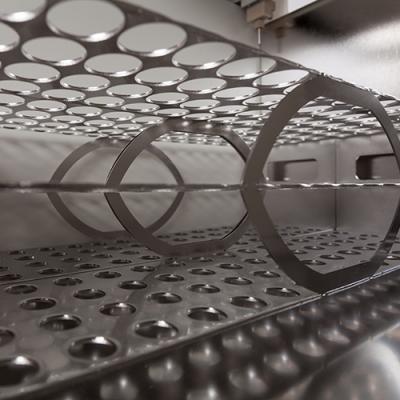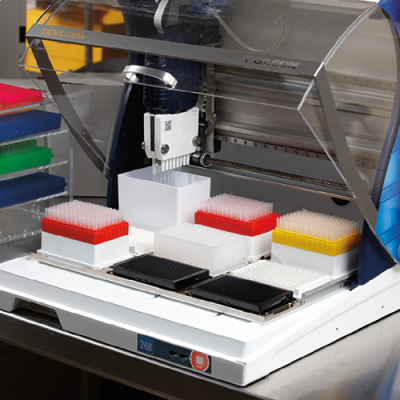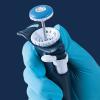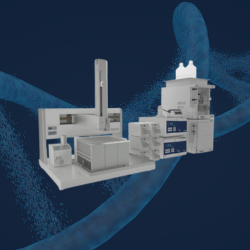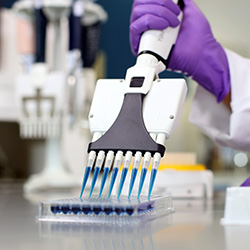The quantitative polymerase chain reaction (qPCR) has transformed the world of molecular biology methodology by enabling fast, high-throughput detection and quantification of DNA and RNA in real time. The versatile technique has widespread applications across the sciences, from diagnosing diseases to detecting genetically modified organisms in food. Analysts must execute qPCR experiments with precision to ensure success — but several challenges can arise in the process:
Thankfully, many of these challenges can be overcome by automating the process and choosing the right liquid handling solution to do so. Gilson’s PIPETMAX®, for example, is specifically designed to maximize reproducibility and accuracy. Here, we explore three ways that PIPETMAX can help you run more effective and efficient experiments.
- PIPETMAX Reduces Cross-Contamination for Accurate Results
Contamination in the qPCR workflow can arise from various sources, such as the physical environment or the chemicals used. Due to the high sensitivity of qPCR, even minute amounts of cross-contamination or carryover can be detected, leading to potential issues with the experiment.
Contamination can result in false negatives or positives in your workflow, resulting in unreliable results. Consequently, sample runs may need to be repeated, and in some cases, entire experiments may have to be discarded, leading to increased timelines and costs.
Through automation, PIPETMAX significantly reduces the potential for cross-contamination — thereby minimizing the risk of human error. In a recent study, PIPETMAX was used to generate three qPCR plates, with multiple assays and samples in three different plate layouts. The results of this experiment were as expected, as determined by appropriate controls. There was no evidence of carryover or cross-contamination, despite having positive and negative samples and controls positioned next to each other in a 384-well format. Furthermore, the coefficient of variation (%CV) ranged from 0.16-0.84%, demonstrating the high precision of PIPETMAX in preventing cross-contamination and ensuring accurate qPCR results.
- PIPETMAX Increases Reliability and Integrity Through RNA and DNA Normalization
Not only do experiments need to be reproducible in labs, but between different labs, too. Reproducibility can be challenging, however, due to the highly sensitive nature of the procedure. Subsequently, each step risks introducing errors that can compromise the experiment's integrity.
To enable experiment replication, the Minimum Information for Publication of Quantitative Real-Time PCR Experiments (MIQE) guidelines were established. These guidelines aim to reduce technical errors in PCR reaction setup through standardization and require that the amount of input RNA used for reverse transcription (RT) be normalized.
However, normalization can be challenging, as the volumes change for every tube. Precise calculations and repetitive pipetting are therefore needed, but the process can be tedious and prone to errors.
PIPETMAX offers a solution by providing reproducible, automated pipetting — removing uninspiring manual workflows and thereby reducing the risk of error associated with performing these. The system’s user-friendly software, TRILUTION, is filled with features to improve the ease of pipette programming and workflow streamlining. One such feature, PIPETMAX Normalization Assistant, allows easy importing of Excel files containing concentration data. The software then performs the necessary calculations to achieve normalized volumes, ultimately creating a protocol enabling PIPETMAX to run the experiment.
In a recent example, we normalized human RNA samples using PIPETMAX Normalization Assistant. The system automated the plate preparation process, including the creation of master mixes, standard curve and sample dilutions, robot settings, and reaction setup — freeing up valuable time for scientists by eliminating routine pipetting tasks.
Figure 1. Graphs showing the normalization of human RNA samples with PIPETMAX Normalization Assistant. The concentration of each sample before (top) and after (bottom) normalization are shown. The error bars show the range for concentration measurements using a NanoDrop spectrophotometer.
- PIPETMAX Consistently Pipettes Master Mixes
Precise master mix preparation is essential for running a successful qPCR assay. But when performed manually, it is time- and resource consuming, making it an expensive process. What’s more, qPCR master mixes are typically very viscous, containing components such as glycerol, buffers, surfactants, and detergents — all of which can affect liquid handling. Highly viscous liquids can lead to decreased accuracy and precision, resulting in increased sample variability and reduced reliability.
A pre-wet step can help improve accuracy and precision by ensuring that the inner surface of the pipette tip is fully coated with the solution to be transferred (Figure 2). During the pre-wet step, the sample is aspirated from the source and then dispensed before transfer — either back into the source or a waste container — resulting in a more accurate dispense.
Figure 2. During the pre-wet step, the pipette tip enters the source vessel, aspirates, then dispenses the liquid.
PIPETMAX automates the pre-wetting step, reducing the amount of manual pipetting performed by lab personnel and ensuring reproducible and consistent pipetting. A recent study found that increasing pre-wet cycles from two to four significantly reduced the standard error between sample replicates. The process would be time-consuming to perform manually, but PIPETMAX can achieve it in minimal time — making it a more cost-effective process. PIPETMAX also enables the modification of various parameters to optimize the pipetting, including pipetting speed, volume, equilibration time, and pre-wet options.
It is crucial to perform qPCR experiments accurately and reproducibly to ensure confidence in your results. To achieve your goals, you must find the right liquid handling solution for your needs. PIPETMAX is the ideal choice for qPCR experiments, as it offers reduced errors through automation and consistently delivers the same results — all while being faster, smaller, and more cost-effective than competitor systems.
Our team of experts is ready to provide you with the information and support you need to make the right choice for your laboratory. To request a quote for PIPETMAX or to learn more about how it can enhance your qPCR workflows, get in touch with us today.























